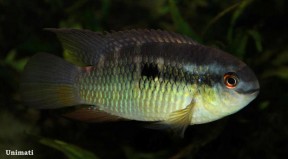Laetacara fulvipinnis
Etymology
Laetacara: from the Latin laetus, meaning ‘happy’, and acará, a vernacular term used for cichlids in certain parts of South America, in reference to patterning around the mouth and snout which give members of this genus a ‘smiling’ appearance.
fulvipinnis: from the Latin fulvus, meaning ‘reddish-yellow, tawny’, and pinna, meaning ‘fin’, in reference to the colour of the anal and caudal fins.
Classification
Order: Perciformes Family: Cichlidae
Distribution
Native to the upper and middle río Orinoco, the rio Casiquiare (aka Casiquiare Canal) and the upper and middle rio Negro in Venezuela and Brazil, with confirmed localities lying between Puerto Ayacucho, Venezuela and Barcelos on the rio Negro in Brazil.
Given this range it would not be suprising if it also occurs in eastern Colombia.
Type locality is ‘lagoon at the village of Arigua, 1°50’13″N, 67°02’29″W, a few kilometers south of San Carlos de río Negro, Venezuela’.
Habitat
Has been collected from habitats containing clear, soft, acidic, tea-coloured blackwater, most typically among leaf litter or submerged vegetation in very shallow (10-50 cm depth) water along the margins of streams and other minor tributaries.
At a village called El Niñal close to the mouth of the rio Pasimoni in the Casiquiare drainage pH was 4.4, electrical conductivity 10 μS/cm and temperature 26.3°C/79.3°F.
Other cichlid species at the locality included Apistogramma uaupesi, Mesonauta insignis, Heros severus and an unidentified Heros sp.
Maximum Standard Length
70 – 75 mm.
Water Conditions
Temperature: 20 – 28 °C
pH: 4.0 – 7.0
Hardness: 18 – 215 ppm
Diet
Wild fish are probably foragers feeding on algae, organic detritus, small insects, worms, crustaceans, and other zooplankton.
In the aquarium it’s easily-fed but the best condition and colours offer regular meals of small live and frozen foods such as bloodworm, Daphnia, and Artemia, alongside good quality dried flakes and granules, at least some of which should include additional plant or algal content.
Sexual Dimorphism
Males grow larger than females and possess more-extended dorsal, anal and caudal fins, while older males tend to develop a steeper head profile.
Nuptial individuals of both sexes develop red colouration on the lower head, opercula and anterior portion of the body but this is not as extensive as in L. dorsigera.
Reproduction
Biparental substrate-spawner which deposits its eggs on a solid surface such as a plant leaf.
Incubation is around three days and the fry are free-swimming approximately a week later.
NotesTop ↑
This species was known as L. sp. ‘orangeflossen’ (orange fins) in the aquarium hobby prior to publication of its official description.
The genus Laetacara currently contains seven valid species and L. fulvipinnis can be told apart from all congeners by the following combination of characters: dorsal-fin usually with 15 spines and 10 rays; 23–25 scales in the E1 row (the row of scales in the horizontal series directly above the longitudinal row and including the lower lateral line); dorsal-fin base only moderately scaly; caudal-fin without a conspicuous pattern of small pale dots; maximum size 74 mm SL.
References
- Staeck, W. and I. Schindler, 2007 - Vertebrate Zoology 51(1): 63-71
Description of Laetacara fulvipinnis sp. n. (Teleostei: Perciformes: Cichlidae) from the upper drainages of the rio Orinoco and rio Negro in Venezuela. - Ottoni, F. P. and W. J. E. M. Costa, 2009 - Vertebrate Zoology 59(1): 41-48
Description of a new species of Laetacara Kullander, 1986 from central Brazil and re-description of Laetacara dorsigera (Heckel, 1840) (Labroidei: Cichlidae: Cichlasomatinae). - Ottoni, F. P., P. H. N Bragança, P. F. Amorim and C. S. Gama, 2012 - Vertebrate Zoology 62(2): 181-188
A new species of Laetacara from the northern Brazil coastal floodplains (Teleostei: Cichlidae).








March 25th, 2017 at 4:19 am
Chris Englezou in his recent blogs on C.E Fish Essentials states he found thus species in the Rio Atacavi,which is a new location for fulvipinnis.